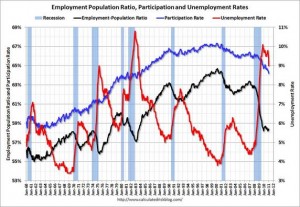
Governor Walker signed “right to work” (RTW) legislation earlier this week, which it is fair to say has led to mixed reactions among the electorate. A Wall Street Journal piece touts the “right to work advantage,” whereas Slate.com teaser says “It has never been more painful and humiliating to be a Wisconsin Democrat.” Owie.
(Curiously, the sign on the table in the photo is “Freedom to Work,” rather than “Right to Work”).
Right to Work laws generally allow employees to work in unionized workplaces without paying union dues. In principle, the free-rider problems caused by the elimation of compulsory union dues mitigates union bargaining power, hence lowering wages (ceteris paribus), and increasing employment. Clearly, then, this legislation potentially has fundamental implications for employment, wages, output, and probably a whole lot of other stuff. How is one to sort all this out?
Fortunately, Ed Dolan at EconoMonitor has taken it upon himself to sort it out for us. He begins by providing a nice review of the history and basic logic of RTW legislation. Following that, he reaches the conclusion that, well, it’s complicated:
The bottom line is that the economic effects of RTW laws are not nearly as clear-cut as their advocates and opponents make them out to be. Correlations of RTW laws with wages and employment are economically small even when they are statistically significant. Most problematic of all is the question of causation—does RTW cause observed differences between states, or do pre-existing differences cause the passage of RTW laws?
It’s almost too bad that the effects are so benign, as RTW is a genuine political dynamo. In response to Walker’s signature, President Obama took to his Twitter feed today to “blast” the Wisconsin legislation and encourage the 25 states that don’t have RTW legislation to keep it that way.

